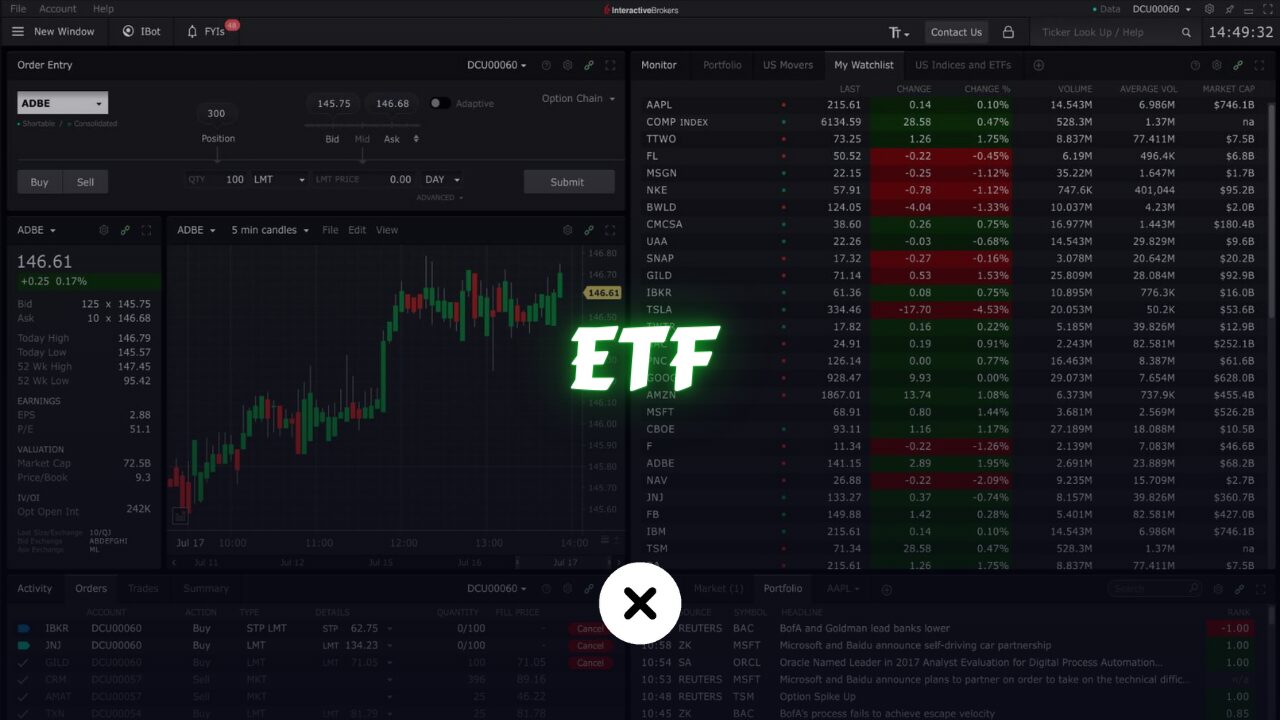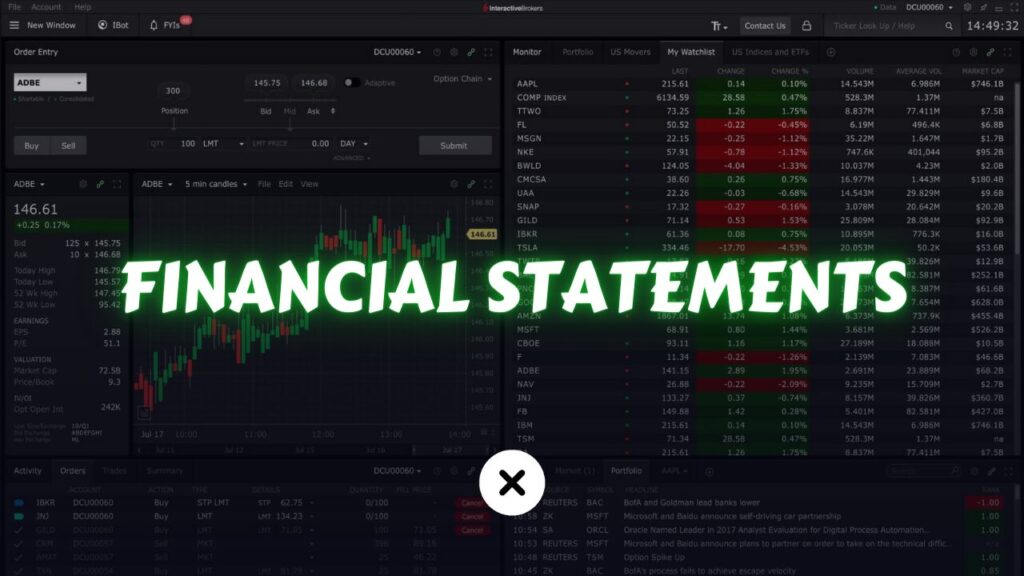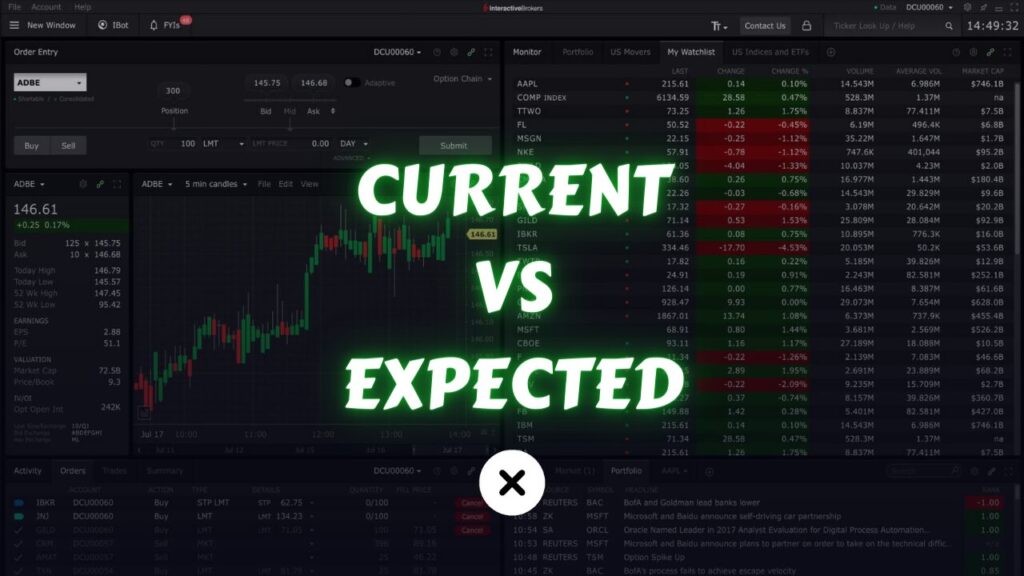
ETFs are a type of investment fund that trades on stock exchanges, similar to individual stocks. They are designed to track the performance of a specific index, sector, commodity, or asset class.
Earlier in our discussion, we explored the concept of indexes. An index essentially functions as a graphical representation that monitors the collective performance of a set of stocks.
However, it’s important to note that we cannot directly buy an index itself. This is where exchange-traded funds, commonly known as ETFs, enter the picture. When you’re interested in investing based on a specific index, you can achieve this by purchasing the corresponding ETF that mirrors that very index.
Characteristics and Features of ETFs
Now, let’s gain an understanding of what an ETF is by learning its characteristics and features.
Structure:
ETFs are structured as investment funds, either as open-end funds or unit investment trusts. The majority of ETFs are open-end funds, which means they continuously issue and redeem shares based on investor demand.
This allows the number of outstanding shares to fluctuate with market demand. Unit investment trusts, on the other hand, issue a fixed number of shares at the inception and do not create or redeem shares after that point.
Index Tracking:
Most ETFs are designed to replicate the performance of a specific benchmark index, such as the S&P 500, Nasdaq 100, or a bond index. The ETF’s value is intended to closely match the performance of the underlying index, before accounting for fees and expenses.
Tracking Error:
Even traditional ETFs, which aim to replicate the performance of their underlying indexes, may experience tracking errors. Tracking errors can occur due to differences in trading times, transaction costs, and management fees. These deviations can cause the ETF’s returns to diverge slightly from the index it tracks over time.
Exchange Listing:
ETFs trade on major stock exchanges, just like individual stocks. Investors can buy and sell ETF shares throughout the trading day at market prices. The ticker symbol of an ETF is used to identify it on the exchange.
Transparency:
The holdings of an ETF are usually disclosed daily, allowing investors to see what assets the ETF owns and in what proportion. This transparency helps investors make informed decisions.
Short Selling and Options:
ETFs can be sold short (betting on their price decline) and can also have options traded on them, providing additional trading and hedging opportunities.
Inverse ETFs:
An inverse ETF is a type of exchange-traded fund that aims to profit from declining prices in the underlying assets it tracks.
These ETFs use various financial derivatives, such as futures contracts and options, to provide returns that are the opposite (or inverse) of the daily performance of the target index or asset.
For example, if the index or asset it tracks decreases by 1% on a particular day, an inverse ETF should gain approximately 1% on that day. As such, inverse ETFs are designed for investors who want to profit from falling markets or hedge against potential losses in their portfolios.
Leveraged ETFs:
Leveraged ETFs are another type of specialized ETF that aims to magnify the daily returns of the underlying index or asset.
These ETFs use financial derivatives to provide a multiple (2x or 3x, for example) of the daily performance of the target index. For instance, if the index rises by 1% on a given day, a 2x leveraged ETF should gain approximately 2% on that day. Conversely, if the index falls by 1%, the leveraged ETF would lose about 2% on that day.
Leveraged ETFs are intended for short-term trading and are not suitable for long-term investments due to compounding effects and potential tracking errors over time.
Market Price and NAV:
The market price of an ETF fluctuates throughout the trading day based on supply and demand. It may deviate slightly from the Net Asset Value (NAV), which is the total value of the ETF’s assets divided by the number of outstanding shares. However, authorized participants keep the market price in line with the ETF’s NAV through the creation and redemption process.
Most Traded ETFs
In the world of ETFs, there are thousands of options available, each serving different purposes, with varying levels of quality.
While some ETFs are better than others, the key is to find the ones that align with your investment objectives. To make this process easier, you can utilize finviz screeners to filter and screen exchange-traded funds, helping you identify the ones that best suit your needs.
S&P 500 ETF:
We are aware that the S&P 500 reflects the performance of 500 U.S. companies, effectively representing the U.S. economy. If you wish to participate in this market, you can do so by purchasing SPY, an ETF that mirrors the S&P 500 index. SPY holds the same positions as the S&P 500 index, investing in the same stocks and maintaining the same proportions. Consequently, this ETF precisely follows the movements of the S&P 500.
For instance, if the index experiences a 1% decline, the ETF will also decline by 1% since it contains the identical stocks in the same proportions.
SPY holds the distinction of being the world’s most liquid and heavily traded product when it comes to stocks.
Volatility Index ETF:
The Cboe Volatility Index, commonly known as the VIX, measures market volatility and investors’ expectations of future market volatility. It is often referred to as the “Fear Index” as it tends to rise during periods of market uncertainty or decline.
Corresponding ETF: iPath Series B S&P 500 VIX Short-Term Futures ETN VXX
Technology Sector ETF:
Index: NASDAQ-100 Index
The NASDAQ-100 Index tracks the performance of the 100 largest non-financial companies listed on the NASDAQ stock exchange. It is heavily weighted towards technology-related companies, making it a popular index for the technology sector.
Corresponding ETF: Invesco QQQ Trust QQQ
Financial Sector ETF:
Index: Financial Select Sector Index
The Financial Select Sector Index includes companies from the financial services sector, such as banks, insurance companies, investment firms, and other financial institutions.
Corresponding ETF: Financial Select Sector SPDR Fund XLF
Healthcare Sector ETF:
Index: S&P 500 Healthcare Index
The S&P 500 Healthcare Index comprises companies from the healthcare sector, including pharmaceuticals, biotechnology, medical equipment, and healthcare services.
Corresponding ETF: Health Care Select Sector SPDR Fund XLV
Energy Sector ETF:
Index: S&P 500 Energy Index
The S&P 500 Energy Index includes companies from the energy sector, such as oil and gas producers, energy equipment manufacturers, and renewable energy companies.
Corresponding ETF: Energy Select Sector SPDR Fund XLE
Consumer Discretionary Sector ETF:
Index: S&P 500 Consumer Discretionary Index
The S&P 500 Consumer Discretionary Index covers companies that produce non-essential consumer goods and services, including retail, media, travel, and leisure.
Corresponding ETF: Consumer Discretionary Select Sector SPDR Fund XLY
Consumer Staples Sector ETF:
Index: S&P 500 Consumer Staples Index
The S&P 500 Consumer Staples Index comprises companies that produce essential consumer goods, such as food, beverages, household products, and personal care items.
Corresponding ETF: Consumer Staples Select Sector SPDR Fund XLP
Industrials Sector ETF:
Index: S&P 500 Industrials Index
The S&P 500 Industrials Index includes companies from various industrial sectors, such as aerospace, machinery, construction, and transportation.
Corresponding ETF: Industrial Select Sector SPDR Fund XLI
Real Estate Sector ETF:
Index: MSCI US Investable Market Real Estate 25/50 Index
The MSCI US Investable Market Real Estate 25/50 Index covers real estate companies in the U.S., including real estate investment trusts (REITs) and other real estate-related firms.
Corresponding ETF: Real Estate Select Sector SPDR Fund XLRE
MSCI Emerging Markets Index ETF:
The MSCI Emerging Markets Index represents companies from 26 emerging market countries, including China, India, Brazil, South Korea, and many others. It provides exposure to the potential growth and opportunities in these developing economies.
Corresponding ETF: iShares MSCI Emerging Markets ETF EEM
MSCI China Index ETF:
The MSCI China Index focuses specifically on Chinese companies, providing investors with targeted exposure to the Chinese economy.
Corresponding ETF: iShares MSCI China ETF MCHI
MSCI India Index ETF:
The MSCI India Index represents Indian companies, providing exposure to one of the world’s fastest-growing economies.
Corresponding ETF: iShares MSCI India ETF INDA
Aggregate Bond Index ETF:
The Bloomberg Barclays U.S. Aggregate Bond Index is one of the most widely used benchmarks for the U.S. bond market. It includes a diverse range of investment-grade bonds, such as U.S. Treasuries, mortgage-backed securities, corporate bonds, and government-related bonds.
Corresponding ETF: iShares Core U.S. Aggregate Bond ETF AGG
Treasury Bond Index ETF:
The Bloomberg Barclays U.S. Treasury Bond Index measures the performance of U.S. Treasury bonds across various maturities, from short-term to long-term. Treasury bonds are issued by the U.S. government and are considered among the safest bonds due to their backing by the government.
Corresponding ETF: iShares 7-10 Year Treasury Bond ETF IEF
IEF aims to track the performance of the ICE U.S. Treasury 7-10 Year Bond Index, which includes U.S. Treasury bonds with maturities between 7 and 10 years. The ETF focuses on intermediate-term Treasury bonds, offering a balance between yield and interest rate risk.
Corporate Bond Index ETF:
The Bloomberg Barclays U.S. Corporate Bond Index measures the performance of U.S. dollar-denominated investment-grade corporate bonds. These bonds are issued by companies with strong credit ratings, making them lower risk compared to high-yield bonds.
Corresponding ETF: iShares iBoxx $ Investment Grade Corporate Bond ETF LQD
LQD seeks to track the Markit iBoxx USD Liquid Investment Grade Index, which includes investment-grade corporate bonds. The ETF provides investors with exposure to a diversified portfolio of corporate debt.
High Yield Index ETF:
The Bloomberg Barclays U.S. High Yield Index measures the performance of U.S. dollar-denominated high-yield corporate bonds. These bonds are issued by companies with lower credit ratings and typically offer higher yields to compensate for increased credit risk.
Corresponding ETF: iShares iBoxx $ High Yield Corporate Bond ETF HYG
HYG seeks to track the Markit iBoxx USD Liquid High Yield Index, offering investors exposure to high-yield corporate bonds. The ETF is suitable for investors seeking higher income potential but comes with higher credit risk.
Conclusion
These are just a few examples of the numerous indexes and corresponding ETFs available in the market. If you wish to gain exposure to various industries, these ETFs provide a convenient method. By observing their performance, you can gauge the overall state of each industry.
SPY is a must-have since it reflects the market’s direction – if it rises, SPY rises, and if it falls, SPY falls. Hence, monitoring SPY is crucial as it provides insights into the overall market.
Depending on your strategy and individual stocks, focusing on specific ETFs that linked to your strategy or stocks can offer valuable information about particular sectors or industries.



